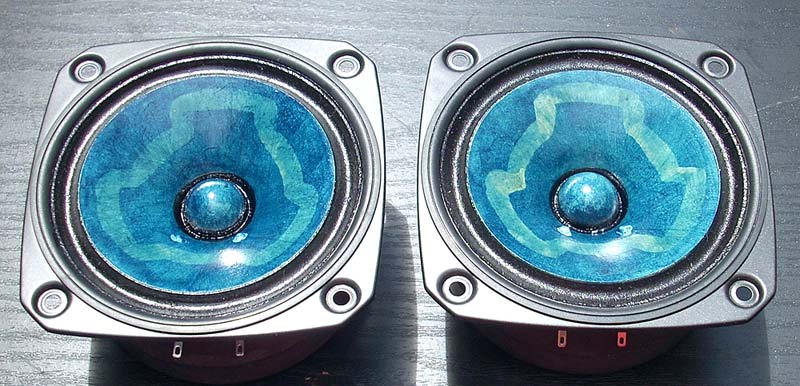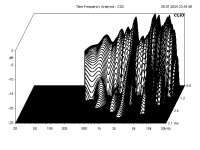I know some really like them but having followed the development of the technology, i heard some of them live, but read many many more papers, AES and other. A driver based on evenly distribited resonances. They have some interesting directivity and dispersion charcteristics made use as overhead tannoys really good.
After NXT went tits up,and the patenbts expired you got Techtonic. Small and round compared to most NXT licenced precursors.
dave
After NXT went tits up,and the patenbts expired you got Techtonic. Small and round compared to most NXT licenced precursors.
dave
Dave do you remember the guy who applied some sort of glue to certain parts of the cone mainly on TangBand speakers.
I think it was on this forum about 15 to 20 years ago.
The before and after distortion plots looked very good.
If memory serves me right his first name was Mark.
I think it was on this forum about 15 to 20 years ago.
The before and after distortion plots looked very good.
If memory serves me right his first name was Mark.
Yes. Mark MacKenzie. I still have a pair of virgin TB W3-881 where i was going to follow his recipe.
The damar pattern we put on the FE127126e was inspired by his work. A pre-treated FE126e that clearly shows the pattern.

dave
The damar pattern we put on the FE127126e was inspired by his work. A pre-treated FE126e that clearly shows the pattern.

dave
Rarely there are fullrange which measure from the scratch near to perfect.
Like tectonic tebm46c20n-4b
That BMR radiator is excellent, but by definition it is not a fullrange driver. It is wide-range driver, because its resonant frequency is 170 Hz - no chance for any low-frequency output. The best use is for coverage of frequency range above 300 Hz.
Scientific proof?
Full set of measurements?
Not proof, but scientific evidence:
Green = Sica 8D1,5CS
Red = Visaton B200
Visaton B200 measured in custom-made OB loudspeaker with two 15" woofers for the low-end.
Sica measured in a cheap plastic PA loudspeaker enclosure, with raised edges and a ton of diffraction above 2 kHz. In spite of that handicap, Sica is better and with more extended frequencies above 10 kHz.
Waterfall diagram of Visaton B200. Ugly, long-lasting resonances, in spite of carefully designed OB loudspeaker.
Waterfall diagram of Sica 8D1,5CS mounted in cheap plastic PA enclosure - much better than Visaton B200, with less resonances and shorter settling time.
Attachments
Last edited:
Red = Visaton B200
They don’t have the needed phase plugs so doesn’t show much… is that measure normalized to 2.83v @ 1m?
If so the B200 will keep falling below 500 Hz down to the real 90-ish dB sensitivity.
dave
Sorry, the burden of evidence is on you - it is you who said the fullrangers are beter than coaxials.You want them, yuou measure them.
I share my measurement (see above post). You don't have some magical measurements other can't do.I do not share my measurements, they are a tool.
YesThey don’t have the needed phase plugs so doesn’t show much… is that measure normalized to 2.83v @ 1m?
If so the B200 will keep falling below 500 Hz down to the real 90-ish dB sensitivity.
Visaton B200 measured in custom-made OB loudspeaker with two 15" woofers for the low-end.
Last edited:
We know enough to differentiate between bad driver (all fullranges) and good driver (a good number of coaxials)That is A/ far too broad, and given all the variables and B/ required evidence does not exist since we still don’t know how to evaluate/measure it/everything needed
Sport cars are faster. No need for science evidence - ordinary evidence is enough, just look at the numbers of the speedometer at both cars."please show us science evidence that sports cars are better than sedans”
2-wheel motorbike car can drive between stacked traffic of 4-wheel cars. Scientific evidence? Use your measuring tape to measure width of cars and motorbikes."please show us science evidence that 2 wheels are better than 4”
But if you can't stand the heat, cold or rain - 4 wheel cars with air conditioning is much better. Also if you have to pick up your wife and 2 children.
PP amps can be much more powerful and in general have much smaller distortion. Read any hi-fi magazine which measure amplifiers."please show us science evidence that PP amps are better than SE”
This one is false. Read above."please show us science evidence that SE amps are better than PP”
False again. Tube amplifiers are worse than transistors. Read any hi-fi magazine which measure amplifiers."please show us science evidence that tubes are better than transistors”
This is easy one. Read above."please show us science evidence that transistors are better than tubes”
Also very easy one. Digital is much better. Read any hi-fi magazine which measure hi-fi equipment.… vinyl and digital…
Last edited:
Because it is you who said the fullrangers are beter than coaxials.Why?
It does exist - see measurements in Audio Science Review and Erin's Audio Corner.Does not exixt for any loudspeaker, and even useful data is thin on the ground for most products.
Useful data is based on heavy science evidence. Read AES papers, they will enlight you.
Klippel NFS does not need anechoic chamber.A basik set (far from complete) requires a big anechoic chamber, a spin-o-rama, vibrometer, laser measuring tools, klippel for a start… and then the experience to be able to interpret the results.
Big chunk of data (Spinorama, etc) is possible with relatively cheap calibrated microphone, good and inexpensive sound card, free REW and free VituixCad. Read this: https://www.audiosciencereview.com/...ents-spinoramas-with-rew-and-vituixcad.21860/
Because it is you who said the fullrangers are beter than coaxials.
No i did not. I said some FRs are better than some coaxes.
There is so very much difference between drivers in a genre wirth such a huge spread in pwerformance and target markets.
dave
Audio Science Review and Erin's Audio Corner
Wouldn’t trust them as far as i could throw them. And i’m kinda crippled.
If you take the scant evidence you posted as having much meaning, little more than those i have posted.
dave
Thanks Dave, I remember now.Yes. Mark MacKenzie. I still have a pair of virgin TB W3-881 where i was going to follow his recipe.
The damar pattern we put on the FE127126e was inspired by his work. A pre-treated FE126e that clearly shows the pattern.

dave
I still got my Fonken enclosure from the FE127
What other speaker would work as substitute in that enclosure?
So you don't trust measurements done with Klippel Near Field Scanner system??? The same Klippel NFS system which Harman International use??? And all other companies which care about the sound quality of their loudspeakers? Here is the list: https://www.klippel.de/company/references.htmlWouldn’t trust them as far as i could throw them.
Yes, all evidence I posted have meaning. Read the AES science papers. Or any loudspeaker book for beginners.If you take the scant evidence you posted as having much meaning,
So you don't trust measurements done with Klippel Near Field Scanner system???
A basik set (far from complete) requires a big anechoic chamber, a spin-o-rama, vibrometer, laser measuring tools, klippel for a start… and then the experience to be able to interpret the results.
Seems i said the opposite earlier.
A note on your graph:
Besides being only an on-axis is shown: 500>1k>2k>4k>8000>16k. About the 5 top octaves. Most of the range of crucial fundementals not shown, and the “problem” areas only the top 2 octaves.
Read the AES science papers
Voraciously. Since 1972.
dave
You are contradicting yourself - you do trust measurements done by Klippel NFS, but you don't trust Audio Science Review and Erin's Audio Corner because they use Klippel NFS?!
My graphs show what is the most important - multiple resonances and slow impulse decay of Visaton B200 at 1380 Hz, 2300, 3180, 4000, 5600, 7160, 8700 Hz and 14400 Hz, and dip at 1100 Hz and 12500 Hz. Enough evidence for a bad loudspeaker.
Frequency response below 500 Hz is not shown because there are no problems there.
Wouldn’t trust them as far as i could throw them.
My graphs show what is the most important - multiple resonances and slow impulse decay of Visaton B200 at 1380 Hz, 2300, 3180, 4000, 5600, 7160, 8700 Hz and 14400 Hz, and dip at 1100 Hz and 12500 Hz. Enough evidence for a bad loudspeaker.
Frequency response below 500 Hz is not shown because there are no problems there.
Last edited:
but you don't trust Audio Science Review and Erin's Audio Corner because they use Klippel NFS?!
No, i just don’t trust or paty attention to them.
dave
multiple resonances and slow impulse decay of Visaton B200
An unfixed B200… as i have implied before, they aren’t very good out of the box. But only a few necessary steps from being quite good.
Your tests are like timinh a cars 0-60 but without tires.
dave
- Home
- Loudspeakers
- Full Range
- Visaton BG20 impressive mod

